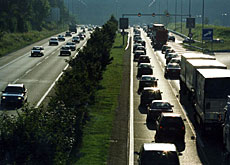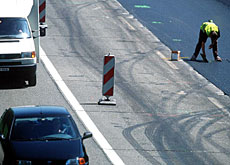Commuting on the rise in Switzerland

More and more Swiss are commuting to work, but journey times have barely increased in the past 30 years, according to the Federal Statistics Office.
Private vehicles are still the preferred means of transport, although there has been a slight increase in rail use.
Figures released on Thursday showed that six out of ten people now commute to work – an increase of ten per cent on a decade ago.
However, while more people are commuting, the amount of time spent getting to work has hardly gone up.
In the past 30 years, just two minutes have been added to the average journey, which now takes a little over 20 minutes.
The Federal Statistics Office said journey times had barely increased because people were choosing faster modes of transport when travelling longer distances.
Car-friendly
Most Swiss prefer to use their own vehicles when travelling to work. Around half of them use a car to commute, up seven per cent on the 1990 census.
Car use is generally higher in French-speaking cantons, except for Geneva. Workers in Ticino are the most addicted to their cars, with around two-thirds of them using a private vehicle to get to work.
There has also been a slight increase in the number of people using certain forms of public transport. Eleven per cent of commuters take the train to work, up just over one per cent on a decade ago.
Use of public transport in towns has on the other hand dropped by two per cent to 10.3 per cent in 2000, while just two per cent of workers use regional services.
Perhaps more surprisingly, fewer Swiss are now prepared to use their bikes (6.1 per cent) or walk (7.9 per cent) to get to work.
Infrastructure
The preferred means of transport for getting to work varies from canton to canton. The citizens of Basel City are less likely to use their car to get to work – just 20 per cent – while over half the workers of canton Solothurn get behind the wheel.
The set-up of public transport infrastructure has a major influence on how people choose to get to work.
The figures, released from the 2000 census, also reveal that one in five Zurich commuters uses the regional rail service to reach their desk.
But one tenth as many people hop on a local train in Geneva because there are just two lines and bad connections.
The country’s urban areas continued to expand over the last decade. Just over 73 per cent of the population now lives in an urban environment, compared with nearly 69 per cent in 1990 and just under 62 per cent in 1980.
The Zurich area now counts more than one million inhabitants, followed by Basel (480,000) and Geneva (470,000). Smaller cities such as Fribourg, Aarau and Vevey-Montreux have also expanded.
swissinfo with agencies
Six out of ten Swiss commute to work, up from 51.7 per cent in 1990.
Over half of them use their car to get to their workplace.
Just over 11 per cent take the train.
Three out of four Swiss now live in urban areas.

In compliance with the JTI standards
More: SWI swissinfo.ch certified by the Journalism Trust Initiative










You can find an overview of ongoing debates with our journalists here . Please join us!
If you want to start a conversation about a topic raised in this article or want to report factual errors, email us at english@swissinfo.ch.